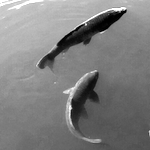Simultaneous swimming and flying that results in take-off from a compliant surface, such as water, presents a complex multibody physics problem integrating locomotor forces, environmental media variances, and dynamic stability. Few organisms have evolved both aerial and aquatic locomotion; one notable example is the flying fish (Family Exocoetidae). More remarkable is the flying fish's ability to taxi on the water's surface before transiting into a stable long-distance glide to evade both fish and bird predators. Our goal is to identify the fundamental properties that enable the flying fish to be both a fast swimmer and long-distance glider. We are particularly interested in the core physical principles that enable accelerated and stable wing-finned aquatic-aerial transitions. To investigate these phenomena, we have developed a biologically-relevant robotic flying fish model organism. To date we have explored the aerodynamic implications of fin position, the lift generated by the pectoral fins in flight, and the forces produced by the tail during swimming. We are currently uniting these mechanisms to explore take-off transition physics.

 PDF version
PDF version
